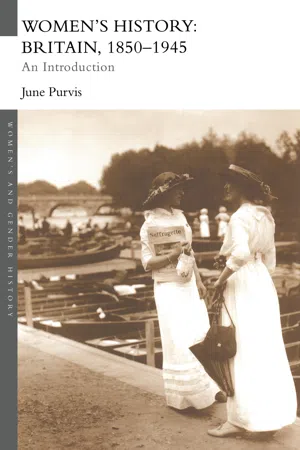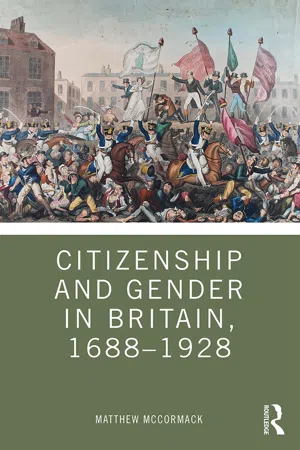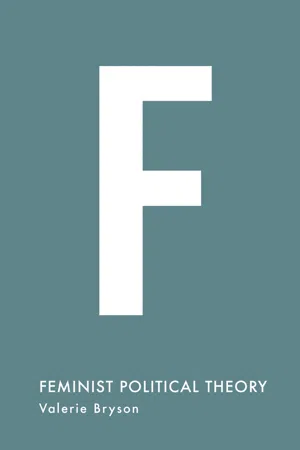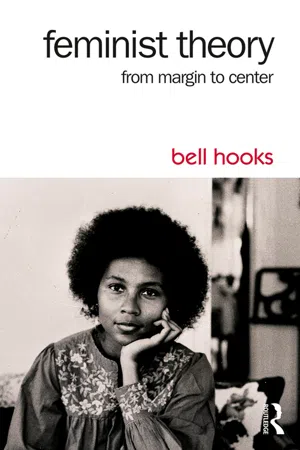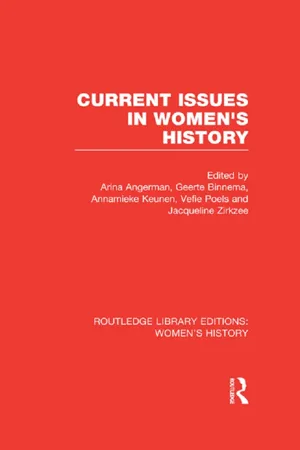History
Feminism in Britain
Feminism in Britain has a rich history dating back to the late 19th century, with key milestones including the suffragette movement and the emergence of second-wave feminism in the 1960s and 1970s. British feminism has been instrumental in advocating for women's rights, challenging gender norms, and addressing issues such as reproductive rights, domestic violence, and workplace equality.
Written by Perlego with AI-assistance
Related key terms
10 Key excerpts on "Feminism in Britain"
- Sarah Gamble, Sarah Gamble(Authors)
- 2004(Publication Date)
- Routledge(Publisher)
I FEMINISM: ITS HISTORY AND CULTURAL CONTEXTPassage contains an image
1 Early Feminism
Stephanie Hodgson-WrightDOI: 10.4324/9780203011010-2Introduction
In Early Modern England feminist activity took a different form from the feminist movement of the twentieth century. Indeed, the issue of whether or not the efforts made by women for better treatment at the hands of men in this period can really be called ‘feminism’ at all is still being debated. However, our own century has shown, and is still showing, us the massive variety of ways in which feminist thought, writing and action can manifest itself. The twentieth century began with the suffragettes fighting for the right to vote, and at its close we see the Spice Girls in bra tops asserting ‘girl power’. The late twentieth-century media has room for both Germaine Greer and Julie Burchill, whose discussion on BBC Radio 4’s Woman’s Hour (February 1999) highlighted that differences in class, education, opportunities and generation will shape different kinds of feminisms. If feminism solidified into a political movement in the 1960s and 1970s, the millennium sees it diversifying again. In the light of this, when we look backwards into the history of women’s struggle against oppression, we are able to identify instances of resistance which we can legitimately identify as feminist in nature, without judging those instances unfavourably against the organised feminism of the twentieth century. For the purposes of this essay, ‘feminism’ will be defined as any attempt to contend with patriarchy in its many manifestations between 1550–1700. Chris Weedon’s definition of patriarchy in Feminist Practice and Poststructuralist Theory (1987) will be employed here:The term ‘patriarchal’ refers to power relations in which women’s interests are subordinated to the interests of men. These power relations take on many forms, from the sexual division of labour and the social organisation of procreation to the internalised norms of femininity by which we live. Patriarchal power rests on social meaning given to biological sexual difference.- Jane Pilcher(Author)
- 2017(Publication Date)
- Routledge(Publisher)
as feminists. Previous chapters have reported survey evidence which indicates age differences on what might be termed ‘feminist attitudes’ (for example, attitudes to gender roles, abortion and pornography). These data show that younger women hold more ‘feminist’ attitudes than older women. As in the present study, these findings were interpreted as functions of cohort, that is, as a consequence of their differing social and historical experiences, including their exposure to feminist arguments and the improved opportunities faced by women, especially in relation to paid work (Martin and Roberts 1984; Witherspoon 1985; Airey and Brook 1986). Although suggesting that younger women hold more ‘feminist attitudes’ than older women, it is not clear from the available data whether older and younger women share common responses to feminism as a social and political movement. The issue of age differences in women’s understandings of and responses to feminism is an interesting one. As Schneider (1988) notes, the women’s movement has always had aims of changing the way women are viewed, both by themselves and by men. Thus, she proposes, an examination of the ways women of different ages, given their differing social and historical experiences, view their lives and feminism is an important exercise. It raises questions about social and political change and notions of collective consciousness. Moreover, as others have noted (e.g. Renzetti 1987), the future growth and prosperity of feminism depends greatly on its attractiveness to new members, who will develop and sustain it in years to come. If contemporary young women are found to respond negatively to feminism, questions are therefore raised about its future. Given the gaps in knowledge about women’s responses to feminism, not least how these may vary by age, asking women in this study for their conceptions of feminism and feminists was a key concern. Before reporting the findings, it is first necessary to sketch a broad history of feminism during the life time of the women whose accounts are the focus of this study, particularly in terms of its changing profile and fortunes.Feminism in Britain in the twentieth century
The historical development of Feminism in Britain can be divided into five more or less distinct phases. First, the nineteenth century, when the central concern was ‘equality’ including in employment, legal rights over property and custody of children and the right to vote. In the second phase, during the early decades of the twentieth century, the struggle for the vote emerged as the predominant concern. Accordingly, feminists of this early period have been characterised as using the vocabulary of ‘rights’ and ‘equality’ (Banks 1981). The struggle for suffrage bestowed unity on ‘the women’s movement’ (as it was then called, see Alberti 1989; Dyhouse 1989), a unity which dissipated in the years after the vote had been achieved. This third period, of the inter-war years, was characterised by ideological and institutional divisions within the movement, which increasingly came to be referred to as ‘feminism’ (Banks 1981; Kent 1988; Alberti 1989). The ‘new feminists’ (a contemporary term) concentrated on issues such as family allowances or endowment, birth control and protective legislation. Priorities such as these were an anathema to egalitarian or equal rights feminists, whose fundamental emphasis was a reorientation of women away from the domestic sphere (Alberti 1989).- eBook - ePub
Women's History: Britain, 1850-1945
An Introduction
- June Purvis, June Purvis(Authors)
- 2008(Publication Date)
- Routledge(Publisher)
28. Erickson, “Introduction”, pp. xii–xiii.29. C.Crosby, The ends of history, Victorians and “the woman question” (London: Routledge, 1991), pp. 1–2.30. G.Dangerfield, The strange death of liberal England (London: Paladin, 1970; first published 1935) p. 145.31. Ibid., p. 145.32. J.Marcus (ed) Suffrage and the Pankhursts (London: Routledge, 1987), p. 3.33. H.Perkin, The origins of modern English society 1780–1880 (London: Routledge, 1969), pp. 149–60.34. Ibid., p. 160.35. J.Mitchell, “Women: the longest revolution”, New Left Review 40, pp. 17–18, 1966.36. S.Rowbotham, Hidden from history: 300 years of women’s oppression and the fight against it (London: Pluto Press, 1973).37. J.Norris, “Women’s history”, North-West Labour History Society Bulletin 7 (1980–1), Special Issue Women and the labour movement, p. 10.38. Ibid., p. 7.39. The Elton quote is made in D.Cannadine, “British history; past, present—and future?”, Past and Present 116, p. 188, 1987. The Hyam quotes are highlighted in M. Strobel, “Sex and work in the British Empire”, Radical History Review 54, p. 178, 1992 which reviews Hyam’s Empire and sexuality: the British experience (Manchester: Manchester University Press, 1990), together with L.White, The comforts of home: prostitution in colonial Nairobi (Chicago: University of Chicago Press, 1990).40. Many definitions of feminism have been offered, but at a most general level it may be defined as a political movement that seeks to eradicate the injustices that women experience because of their sex. Within this broad definition, one may identify various feminisms, each offering differing emphases for the causes of female oppression. Consciousness raising among women about injustices to their sex is a key method of feminism, and a feminist is a women who has experienced this. Indeed, since women’s “experiences” are regarded as the cornerstone of feminist theory and politics, only women can be feminists. Not everyone, of course, will agree with this view—see, for example, B.Harrison, Prudent revolutionaries, portraits of British feminists between the wars (Oxford: Oxford University Press, 1987), where he includes two “male feminists”, Henry Harben and Frederick Pethick-Lawrence, in his group biography. For a general overview of some of these issues, see A.Jardine & P. Smith (eds), Men in feminism - eBook - ePub
- Robert Leach(Author)
- 2015(Publication Date)
- Bloomsbury Academic(Publisher)
Cutting across this time dimension the literature also commonly distinguishes between varieties of feminism. Liberal, Marxist and radical feminism were the three main strands of early second-wave feminism, to which other subcategories have been added more recently, such as eco-feminism, black feminism or post-modern feminism. Such classifications help to make sense of a complex range of feminist thinkers, ideas and issues, and some use is made of them here. However, such classifications always involve some oversimplification and distortion.It is also worth emphasizing that feminist theory largely transcends national boundaries. Feminism in Britain has been significantly influenced by French, American and Australian thinkers, whose work is discussed here alongside that of British writers. However, as this book is concerned with ideology in Britain, it focuses particularly on the British women’s movement and its attempts to remedy discrimination and exploitation within the economic, social, political and legal context of the United Kingdom (Carter, 1988; Lovenduski and Randall, 1993; Lovenduski, 2005; Childs, 2008; Cochrane, 2010, 2013).The origins and development of feminist thought: liberal feminismMuch early feminist writing involved the application of liberal assumptions and values to the position of women. Although most male liberals initially were reluctant to extend the ‘rights of man’ to woman, a few men and rather more women brought up within the liberal tradition argued that women could and should compete on equal terms with men. These liberal feminists sought the same education for women as for men, and the same civil rights and economic opportunities (Tong, 1992, 13–22). Among British writers who contributed to the predominantly liberal ‘first wave’ of feminism were Mary Wollstonecraft, John Stuart Mill and Harriet Taylor, while more recent second-wave liberal feminists include the Americans, Betty Friedan, Susan Moller Okin and the British writer Janet Radcliffe Richards.Mary Wollstonecraft’s A Vindication of the Rights of Women (1792) is still widely regarded as the first key feminist text. It was written soon after the outbreak of the French Revolution and the Declaration of the Rights of Man, and the appearance of Tom Paine’s Rights of Man. Its fundamental assumptions were those of liberalism – the rights, freedom and equality of the individual – applied specifically to the position of women. Wollstonecraft argued that women were as capable of reason as men, and should be educated in the same way as men. They should be free to exercise their reason and choose their role in life. An equality of worth between men and women implied an equality of rights, including political rights. Wollstonecraft’s short but dramatic life, faithfully described by her husband, the anarchist thinker, William Godwin (see Chapter 5 - eBook - ePub
- Matthew McCormack(Author)
- 2019(Publication Date)
- Routledge(Publisher)
7 Feminism and citizenship Feminism concerns the advocacy of women’s rights, often in terms of seeking equality with men. The term was first used in this modern sense in the 1890s and it is the period around the turn of the twentieth century that is commonly referred to as the ‘first wave’ of British feminism. This was the period of the New Woman and the suffragettes, when the campaign for women’s rights was more public and visible than ever before. Characterising this activity as the ‘first wave’, however, begs the question of whether feminism can be said to have existed before it. The suffragette generation themselves acknowledged their debt to their forebears: some sought to write the history of earlier campaigns, or were veterans who had been active for decades. In this chapter, we will focus on the two centuries before the ‘first wave’. We will employ the label ‘feminist’ retrospectively in order to think about the history of campaigners who sought to critique women’s subordinate position in British society and politics. These included men as well as women, and conservatives as well as radicals, so may not always look like feminists to twenty-first-century eyes: following the ‘second wave’ of the movement in the 1960s and 1970s, we tend to associate feminism with the radical left of the political spectrum. In some cases it may not be clear whether the term ‘feminist’ applies or whether they would have accepted such a characterisation themselves. Nevertheless, the campaigns and campaigners explored in this chapter will differ from the examples of mainstream political activity that we examined in Chapter 5, since they sought to address women’s position in society rather than to work within it - eBook - ePub
- Valerie Bryson(Author)
- 2016(Publication Date)
- Bloomsbury Academic(Publisher)
5 LEFT-WING Feminism in Britain AND THE UNITED STATES FROM THE LATE NINETEENTH CENTURY TO THE SECOND WORLD WARAs we shall see in Chapter6 , by the late nineteenth century some European countries saw a sharp split between ‘mainstream feminists’ with their demands for equal political and legal rights, and Marxist socialists with their talk of class war and revolution. In both Britain and the United States, however, there was much more of a continuum, as the social concerns that had long characterised sections of the women’s movement merged with a more radical critique of existing society which led some to socialism as well as feminism. For most, this socialism was based on humanitarian ideals or a pragmatic response to poverty and the conditions of working-class life. Such socialism owed little to Marxist ideology, it favoured gradual and piecemeal reform rather than revolution, and it could seem readily compatible with a feminism based on ideas of social justice rather than on an analysis of patriarchy. In this context, socialism and feminism could be seen as complementary, promising equality and an end to exploitation for all. At the same time, other women activists developed their feminism in the context of anarchist or communist politics, insisting both that society must be radically transformed and that women must play a key role in this transformation, while some black women communists developed analyses of the intersections of race, class and gender that anticipate later thinking.BritainAlthough many male socialists supported feminist goals, in practice socialist organisations in both countries tended to combine formal commitment to a degree of sex equality with a marginalisation of ‘women’s issues’, discriminatory practice and a frequently unthinking sexism that permeated all levels of political and personal life. Thus Hannah Mitchell, a working-class socialist and suffrage campaigner from the north of England complained: - eBook - ePub
Feminist Theory
From Margin to Center
- bell hooks(Author)
- 2014(Publication Date)
- Routledge(Publisher)
Since bourgeois white women had defined feminism in such a way as to make it appear that it had no real significance for black women, they could then conclude that black women need not contribute to developing theory. We were to provide the colorful life stories to document and validate the prevailing set of theoretical assumptions. (An interesting discussion of black women’s responses to feminist movement may be found in the essay “Challenging Imperial Feminism” by Valerie Amos and Pratibha Parmar.) Focus on social equality with men as a definition of feminism led to an emphasis on discrimination, male attitudes, and legalistic reforms. Feminism as a movement to end sexist oppression directs our attention to systems of domination and the interrelatedness of sex, race, and class oppression. Therefore, it compels us to centralize the experiences and the social predicaments of women who bear the brunt of sexist oppression as a way to understand the collective social status of women in the United States. Defining feminism as a movement to end sexist oppression is crucial for the development of theory because it is a starting point indicating the direction of exploration and analysis.The foundation of future feminist struggle must be solidly based on a recognition of the need to eradicate the underlying cultural basis and causes of sexism and other forms of group oppression. Without challenging and changing these philosophical structures, no feminist reforms will have a long-range impact. Consequently, it is now necessary for advocates of feminism to collectively acknowledge that our struggle cannot be defined as a movement to gain social equality with men, that terms like “liberal feminist” and “bourgeois feminist” represent contradictions that must be resolved so that feminism will not be continually co-opted to serve the opportunistic ends of special-interest groups. - eBook - ePub
Perspectives on Feminist Political Thought in European History
From the Middle Ages to the Present
- Tjitske Akkerman, Siep Stuurman, Tjitske Akkerman, Siep Stuurman(Authors)
- 2013(Publication Date)
- Routledge(Publisher)
52 The history of nineteenth-century feminism cannot be separated from these diverse contexts, and historians of Southern and Eastern or Central European feminism have warned against compressing the history of European feminism into one single model.Nevertheless, it is hard to deny that feminism was more successful in Northwestern Europe than in the rest of the continent. When we trace the most favourable conditions for the emergence of feminist mass movements at the end of the nineteenth century, it is very plausible that Protestantism on the one hand and a liberal-democratic culture on the other were the crucial factors. Generally, feminist organizers and authors in Northwestern Europe forged their own ideas in a continuous critical dialogue with liberalism, Protestant thought and, later on, with socialism. In these parts of Europe, late nineteenth-century feminism was part of a broad movement of ideas that accompanied the democratization of society and the state.CONTEMPORARY FEMINISM(S)
As Jet Bussemaker observes in chapter 13 , contemporary feminism is multifarious and hard to define. The movement we have provisionally christened ‘the sixth wave’ is still continuing today, and there is, as yet, no consensus about its historical significance and eventual results. Contemporary feminism encompasses an extremely broad range of substantial issues, organizational forms and political styles. Its kaleidoscope of programmes seems to condemn all definitional exercises and neat taxonomies as so much vanity. Its manifold languages have appropriated and transcended almost all previous feminist discourses. It sometimes appears in an outright abstract-philosophical and even anti-historical guise, but at the same time it has probably produced a greater awareness of women's past and the history of feminism than has ever existed before. The cultural and intellectual variety of contemporary feminism is matched by its organizational diversity, ranging from informal consciousness-raising groups to single-issue campaigns and huge, nation-wide formal organizations. Moreover, contemporary feminism has from its very beginning been an international - eBook - ePub
- Mary Evans(Author)
- 2016(Publication Date)
- Polity(Publisher)
25Feminism faces, as it has always faced, the problem of how it is to intervene in the social world and what the term ‘feminism’ might mean across the world. But it does so in the context of what can be described as a third phase of the engagement of feminism with the modern, in which it has to encounter a truly global culture and new kinds of complexities in the loyalties of individuals to both their own and imported cultures. In this context, it is useful to look back at feminism and attempt to define those consistencies in it, the moments of the most inclusive feminist politics, as well as those moments when there is considerable dissent and disagreement. In terms of global history, there would seem to be two themes which more than others have united women in various forms of feminist campaigns. One has been the demand for women to have the same degree of control over their person as that of men: rights to the same civic status and to autonomy as an individual. This would appear to be, at least in terms of the law and/or written constitutions, a relatively straightforward matter to achieve, a matter of ensuring gender neutrality in the letter of the law. But of course achieving this has been very far from simple and is still resisted in many countries. Nor is it necessarily only resisted by men; as was the case in campaigns on suffrage and divorce in Britain, there were, and are, important minorities of women who do not support more inclusive policies. Although it is now widely suggested, in terms of both the United States and Britain, that women are more likely to vote for left-of-centre political parties than men are, a glance at the literature on voting in both countries shows that this was not always the case and that, for example, throughout the 1950s in Britain, women were identified as more likely to vote for the Conservative rather than for the Labour Party.26 This in itself is perhaps not surprising, since it is supposed that the public culture of Britain in the 1950s, in common with that of the United States, was one which was far from radical in its gendered assumptions. But, as various authors have pointed out, what may have appeared as the settled conservatism of the 1950s hid important currents of dissatisfaction and make the appearance of a new form of femininity in the 1960s less surprising.27 This new form of woman no longer appears in advertisements in a rapturous relationship with her kitchen but is now expressing a more than active interest in the world outside. This returns us to the importance of that transformation of the aesthetic of gender in the 1960s and the 1970s: the emergence of the happy young woman who was famously portrayed as ‘having come a long way’.28 - eBook - ePub
- International Conference on Women's History, Arina Angerman, Geerte Binnema, Annemieke Keunen, Vefie Poels, Jacqueline Zirkzee(Authors)
- 2012(Publication Date)
- Routledge(Publisher)
The origins of feminism in Egypt
Margot BadranFeminism emerged in Egypt while the modern state was in process of formation. It arose at a moment of growing urbanisation, with the expansion of capitalism bringing incorporation into the European-dominated world market system, and later British colonial occupation. Feminism appeared in Egypt, as in Western countries, amongst upper- and middle-class urban women. However, unlike in the West but as commonly in the Third World, feminism in Egypt became bound up with nationalism and found legitimisation in religion.1In her book on the origins of modern Feminism in Britain, France and the United States, Jane Rendall discusses the social conditions under which feminism emerges and draws attention to the increasing separation of women and men, with the growing division between the home and the place of work. She speaks of a new domestic world of women in which they created a culture of their own that gave them the opportunity for self-assertion.2 In the case of Egypt, feminism emerged when the formerly strict seclusion of women imposed by patriarchal authority broke down increasingly in the last third of the nineteenth century. Women displayed new forms of self-assertion as they began to transcend the old world of imposed domestic confinement, broadening their horizon and paving the way towards a sexually integrated world. It, was sometimes thought, because (middle- and upper-class) women in Egypt were separated within their own world, that there was a broad female community, but women were distanced from each other within individual households while female seclusion was at its strictest.3Such historical differences demonstrate the diversity of social, economic and political conditions that have given rise to feminism. Feminism is a response and challenge to patriarchal domination and is at root a universal phenomenon. It is important to emphasise that feminism is a generic phenomenon with specific local or indigenous historical manifestations. It has been widely alleged in the Middle East and elsewhere in the Third World that feminism was (or is) a Western phenomenon, tainting and delegitimising it in countries in a colonial and post-colonial context. The aim of this paper is to contribute towards extending our knowledge of specific feminist historical experience, particularly in the Third World, and towards the expansion of theories on the origins of feminism.
Index pages curate the most relevant extracts from our library of academic textbooks. They’ve been created using an in-house natural language model (NLM), each adding context and meaning to key research topics.


